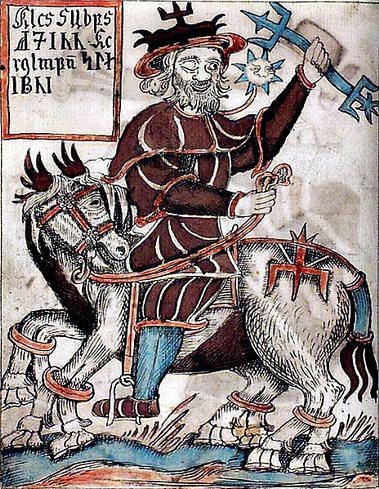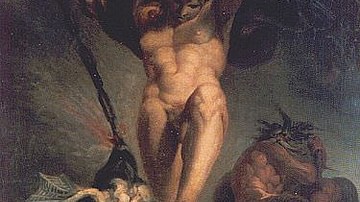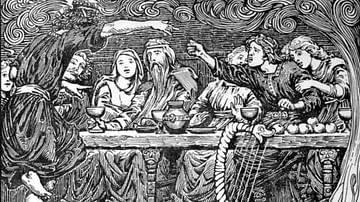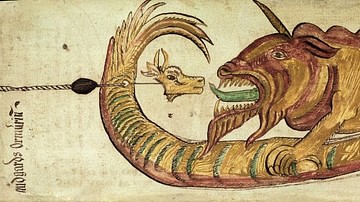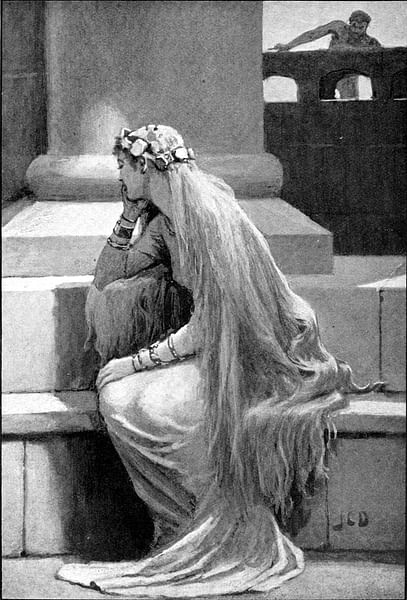
Sif is a fertility goddess in Norse mythology, wife of the thunder god Thor, best known for the story in which the trickster god Loki cuts her hair as a prank and is forced to replace it with a magical headpiece, leading to the creation of several other well-known enchanted items including Thor’s hammer.
She is the mother of Thor’s daughter Thrud and a son, Ullr, by an unnamed father, who was the god of archery, hunting, and skiing in the Pre-Viking era. The Prologue to the Prose Edda lists a number of other children, but most, other than Moda and Magi, are never mentioned again. Sif is traditionally depicted with long, golden hair which some scholars claim symbolizes wheat. In this interpretation, she is part of a divine fertility couple as she represents the soil of the earth and Thor, a sky god, the rain that fertilizes that soil to produce crops.
Several scholars, including Rudolf Simek, reject this interpretation as Sif never had the kind of cult following as other fertility goddesses such as Freyja and Frigg and only appears in the story of her unwelcome haircut as the catalyst for the creation of six magical items. Besides this story from the 13th-century Prose Edda (written by the Icelandic mythographer Snorri Sturluson, l. 1179-1241), she is also mentioned briefly in the Lokasenna ("Loki’s Taunts") and another work from the Poetic Edda questioning her virtue and fidelity.
No tale directly associates her with fertility, and her name translates as "relation by marriage" (according to Simek, 283) or "in-law relationship" (Lindow, 266). She is usually understood, therefore, as simply Thor’s wife who was given this name at a time when Thor was understood as a fertility god and established myths involving Freyja and Frigg disqualified them as candidates for Thor’s wife.
Sif’s Haircut & the Magical Items
In the Skáldskaparmál ("Language of Poetry") section of the Prose Edda, Sif makes her most important appearance. The story begins with Loki thinking about some mischief he can cause and deciding it would be fun to shave Sif’s head while she sleeps. Since Sif’s hair was her defining characteristic, the loss of it would provide Loki with some amusement while no doubt also enraging her husband Thor, so a win-win proposal in Loki’s mind. Loki shaves Sif bald as she sleeps beside Thor and, when he wakes and sees her, he flies into a rage, instantly knows Loki is to blame, and finds him, threatening to break all his bones at once unless he restores Sif’s hair.
Loki apologizes and begs to be released to go to the realm of the dwarves beneath the earth. There, he assures Thor, he will have the great craftsmen, who can forge anything, make Sif a golden head of hair more impressive than her original. Thor releases Loki, and he heads quickly to Svartalfheim under the earth.
There are slightly different versions of the myth but, essentially, Loki finds the sons of the great dwarf craftsman Ivaldi, Brokkr, and Sindri (also given as Brokk and Eitri) and asks for their help. They make Sif a beautiful headdress of gold to replace her hair and then create five other magical items:
- The ship Skidbladnir, the fastest of all ships that can fold up and be carried in a pocket
- Odin’s spear Gungnir that always finds its mark
- The Golden Boar of Freyr, Gullinbursti
- The magical ring Draupnir, which birthed eight new rings every ninth night
- Thor’s hammer Mjölnir (“Lightning”), which would always return to his hand
The dwarves had made the first three items and were prepared to deliver them to the gods and receive their reward when Loki, again feeling mischievous, taunted them with a wager: he bets his head against their ability to forge three more as impressive as those just finished. Brokkr and Sindri accept the challenge, and Brokkr begins working the bellows while Sindri conjures the magic required.
Loki transforms himself into a gadfly and stings Sindri’s hand, but the dwarf ignores the pain and draws the golden boar from the fire. Next, as they begin to work again, Loki-the-gadfly stings Brokkr’s neck, but the dwarves continue and produce the magical ring. Loki, now starting to panic, understands he must ruin the last piece to keep his head and so stings Brokkr above his eye, gashing it so blood flows down his face.
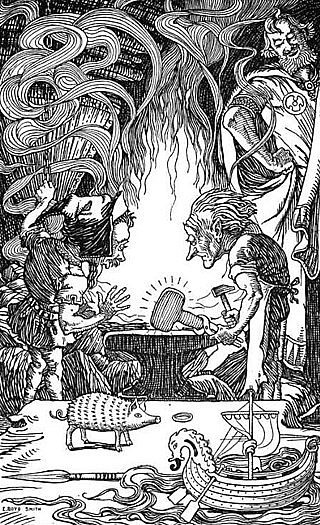
Brokkr continues to work the bellows while Sindri fashions the piece in the fire and draws out the magic hammer. Because Brokkr could not see what he was doing, however, the handle of the hammer is shorter than envisioned. Still, it will return to the hand of its owner once thrown and the dwarves are pleased enough with it to gather it with the rest to give to the gods.
Loki-as-gadfly takes all six items and hurries to Asgard to present them as gifts before the dwarves can arrive and tell anyone about the wager. He presents Sif with her new hair and Thor with the hammer; he gives Odin the ring and spear; Freyr receives the magic ship and boar. The dwarves arrive, tell the gods of the wager, and demand Loki’s head, which the gods say they can have despite the wonderful gifts he has given them. Loki points out, however, that he only bet his head, not his neck, and there is no way for them to remove his head without damaging the neck. The dwarves confer and then settle for sewing Loki’s mouth shut tightly before returning home.
Sif as Prize in Odin’s Race
Sif plays a minor role in the above tale - any other catalyst could have been used just as easily to send Loki to the dwarves for them to create the items – and this is true of the other stories she appears in. She seems to have a clear identity as a once-fully-realized character, but in the stories featuring her, she serves primarily as a plot device that drives the action.
In the story of Odin’s horse race with the giant Hrungnir, Sif is claimed as a prize by the giant even though he has lost the race. After Odin has claimed the magical horse Sleipnir as his steed, he rides through the Nine Realms of Norse cosmology and eventually arrives in Jotunheim, land of the frost giants. Hrungnir admires Sleipnir but claims his own horse, Gullfaxi (“Golden Mane”) is the fastest and best in all the worlds. Odin challenges him to a race and the two set off galloping toward the finish line at Asgard.
The other gods have opened the gates for Odin and plan on slamming them shut at Hrungnir’s approach, but the giant is directly behind Odin as they finish and is now within the realm’s walls. Odin feels compelled to offer hospitality and gives Hrungnir a drink, which the giant finishes quickly and then demands more. Hrungnir becomes drunk and loud, threatening the Asgardians with destruction and yelling that he will take the two most beautiful goddesses, Freyja and Sif, as prizes back to Jotunheim along with Odin’s Hall of Heroes, Valhalla.
The gods already despise Hrungnir for abducting Thor’s and Sif’s daughter Thrud at some point. Thrud is possibly a Valkyrie who escaped from Hrungnir or possibly another woman; there is no tale of her abduction by the giant, only a reference to it. After Hrungnir has bellowed beyond the point the gods can stand – and especially after his threat to abduct Freyja and Sif - they call for Thor who arrives, challenges the giant to a duel, and kills him by smashing his skull into pieces with his hammer. The giant’s corpse falls on Thor, pinning his neck under one gigantic leg, and Thor can only be freed by his mighty three-year-old son Magi who then receives Gullfaxi as a gift in gratitude.
Sif in the Poetic Edda
In the Poetic Edda, Sif also makes brief appearances and only speaks once. In the poem Hárbarðsljóð ("The Lay of Harbardr"), Thor is returning to Asgard from adventures in Jotunheim and comes to a ferry run by a man named Harbardr (who is actually Odin in one of his disguises). Thor asks for passage across the water but the ferryman insults him instead. He tells Thor that he should exert some effort to dress better since he looks like a beggar. He then tells Thor of his various magical abilities and that he knows Thor’s wife Sif is even now at home with a lover. Thor accuses him of lying and insults him further. The contest between Odin and Thor continues as Harbardr keeps abusing Thor without seeming to take anything he says seriously and, in the end, Harbardr still refuses to let Thor pass.

In the verse Lokasenna, Loki also mentions Sif’s infidelity. The Lokasenna is set at a great banquet of the gods Loki has been expelled from for killing a servant. He returns, however, citing an oath Odin took once that he would never drink unless Loki was present and so Odin makes room for him at the table and Loki instantly begins insulting every god present. After he has annoyed a number of them, Sif comes toward him and offers him a horn of mead. She says:
Hail to you, now, Loki
Take this drink I offer you
Of our good old mead.
Do this, rather than find fault
With me, alone among
All the gods and goddesses.(Verse 53, quoted in Crawford, 111)
Her speech is understood to mean that she, "alone among all the gods and goddesses" is innocent of any wrongdoing and so there is no need for Loki to insult her since no failings can be attributed to her. Loki, however, responds:
You would be unique, Sif,
If you actually were
Wary and unwelcoming to other men.
But I alone know
How you were unfaithful
To your husband Thor –
And I was the one you slept with.(Verse 54, quoted in Crawford, 111)
Since Loki insults all the goddesses at the banquet in the same way, charging them with infidelity and promiscuity, there is no way of knowing whether he is telling the truth about Sif. It is possible, however, that he is and that she brings him the mead in the hope that he will not reveal their affair. Thor is not present when Sif and Loki have their exchange, and Loki does not bring up the affair once Thor arrives.
After the banquet, Loki tries to hide from the wrath of the gods – stirred up not just by the insults but because of his role in the death of the beloved god Baldr – but is finally caught and chained in a cave below the earth with a serpent above him dripping venom on his head. Even though Loki frequently tells lies as part of his schemes, he is also known to speak the truth, so it is possible he and Sif did have an affair. This would not be unusual since fertility goddesses are often depicted as having sexual relations with men other than their chosen mate.
Sif as Fertility Goddess
It is possible that Sif is given such brief treatment in the stories because she was once a well-known fertility goddess – later replaced by Freyja, Frigg, and others – who would have needed no further details for an audience to understand who she was and what she represented. Norse mythology was passed down orally for centuries until Scandinavia and then Iceland was Christianized between c. 1000-1100 and literacy was introduced. As scholar John Lindow has noted, all the Norse myths now extant were written by Christians who preserved them either to refute the belief system or for reasons never given.
Sif, then, may have been a popular pre-Christian goddess whose stories were ignored by the Christian scribes or who, by their time, had already been replaced by Freyja and Frigg – two fertility goddesses also accused of infidelity and promiscuity. The fertility goddess always symbolized some aspect of the earth and its abundance – in Sif’s case the soil – and taking more than one mate is thought to represent the earth’s receptivity to fertilization.
Suggestions that there was an established cult dedicated to Sif, however, have been challenged as these claims lack any support from the primary sources. Sif is never actually defined as a fertility goddess. It could be that Sif is given such brief treatment because she was only created as a plot device and never served any other purpose. Scholar Rudolf Simek, among others, claims that the tale of Sif’s haircut was invented by Sturluson (who added his own touches to a number of myths) and that her hair does not represent wheat or any other cultivated crop:
Sif’s golden hair has been seen mostly as a mythical picture for the gentle waves of a [wheatfield] which is cut every year and yet grows again the year after; but even [the great mythographer Jacob Grimm] was skeptical of this interpretation; the fact that a particular kind of moss is called haddr Sifjar 'Sif’s hair' in Old Norse also clearly contradicts this hypothesis. Therefore, it seems that the vegetation cult, which various scholars wanted to assume for Sif, deriving from the connection with her golden hair, is the mere product of an over-zealous interpretation of Sturluson’s anecdote which has added the fairy-tale motif of the golden hair to the creation of the various attributes of the gods; otherwise, there is no reason to assume a cult of Sif. (283)
Simek’s claim might be correct, but there is really no way of knowing whether Sif existed in pre-Christian Norse beliefs since, as noted, they were not written down. The earliest skaldic poetry addressing mythological events and themes only come from the Christian era by which time Freyja and Frigg were already prominent fertility goddesses and Sif may have long before been replaced.
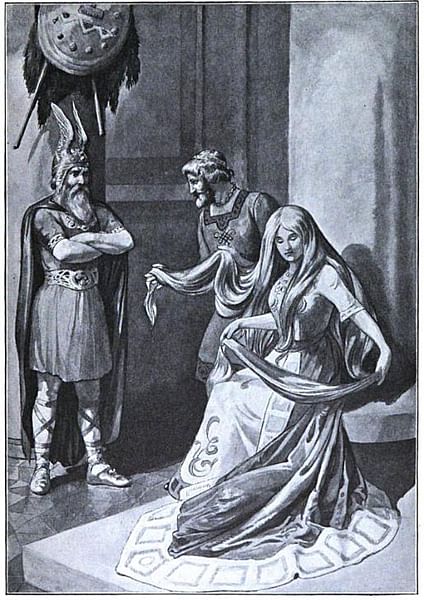
Conclusion
Whoever she may have been in an earlier era, the extant tales depict her only as Thor’s wife and her name supports the claim that this is the function she was created for. The moss known as Sif’s hair that Simek references would have been named in honor of the wife of Thor because it looked like the description of her hair; the hair, then, would not have represented wheat at all but was simply intended as a compliment to Sif’s femininity which was often symbolized by long, luxuriant hair.
In the present day, Sif is best known from the Marvel Cinematic Universe’s films Thor (2011) and Thor: The Dark World (2013) as well as the TV series Marvel’s Agents of S.H.I.E.L.D. and Loki (played by actress Jaimie Alexander) where she is imagined as a warrior-goddess who, in the films, fights by Thor’s side but is not his wife. The mythological Sif bears no resemblance to the character in the Marvel films as she is never referenced as a warrior-goddess in any way.
The two times she is featured in stories she is shown as either the victim of a prank her husband must avenge, resulting in some of the Norse gods’ best-known attributes, or as a guest at a banquet. Any later depictions are a reimagining of the goddess with no basis in the mythology she comes from. Even so, the latest vision of Sif is in keeping with the spirit of Norse goddesses as independent entities as capable as any god of fighting for what they believe in and, in this regard, Marvel’s Sif would no doubt meet with approval from her medieval inspiration.
